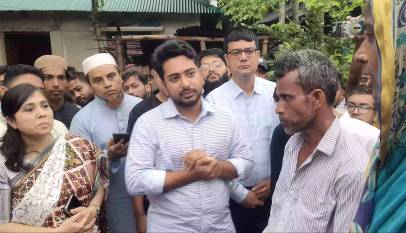More than 500 rivers disappear in 50-yrs
Mahfuja Mukul: Soon after liberation, there were 1,274 rivers in Bangladesh. Now there are about 700. About 500 rivers have disappeared in 50 years. This is a very big warning.
Bangladesh is a riverine country – the saying is now becoming history. At one time the water demand of Bangladesh was met from the river. The communication system was also dependent on the river. That day is no more. The river is slowly disappearing. There is a crisis of clean water. If this continues, the rivers will eventually have a large negative impact on the environment. The river pollution must be stopped and encroachment freed after the crisis has passed. At the same time, the river should be saved and included in public life. That’s what the experts say.
Ejaz Hossain, Chairman of River and Delta Research Center said,when Bangladesh became independent, there were 25,140 kilometers of rivers in Bangladesh. Now it has come down to less than a half.
He said, the rivers of Bangladesh are dying or being killed. There is a reason for this. We don’t get water from upstream. River means water. The rivers are being destroyed without water. It is much easier to take over when the river dries up due to lack of water. Besides, there is a lot of political corruption. All riverine occupiers are generally associated with dominant groups. Due to these reasons, we are finishing the river today.
We have done a survey, he said, suggesting to re-integrate the river with public life by restoring it. We have seen that during the liberation war we had 1,274 rivers. Now there are about 700. About 500 rivers have disappeared in 50 years. This is a very big warning. Now if we want to save the rivers, we have to do something.
First of all, the river channels should be fixed. Because the other environmental needs of the river will be met only when people give importance to it as a means of transportation. There is no dirt on the road that people walk on. When people walk on the road in the village, grass grows there. It will be clean only if the river is used in the same way.’
Suggesting how to save the river, he said, there are several lakh canals in Bangladesh. Only LGED has made culverts and roads on three lakh canals. Due to this, the water network of canals connected to the river has been destroyed. That’s why we say, this year’s theme is the waterway in our public life. If we can save the canal by removing the culverts, the rivers will actually come back.
The waterways that exist now are for commercial reasons. The waterways still exist for trade and passenger transport. Buriganga, Dhaleswari, Meghna, Jamuna are being preserved for commercial reasons. Its beneficiaries are not ordinary people. Its beneficiaries are the state and those who are doing business. So, we think that if we can bring back the river course that was there before at the micro level, then the rivers can be saved. The government has to find out afresh what the obstructions were on the river.
We need rivers for environmental needs. But if we save the river for navigation, then all the needs will be met.
Inamul Haque, the former chief engineer of the Water Development Board told that there are two sources of rivers in Bangladesh. One is from inland water bodies. And some come from outside or inside the country. Those that come from outside, we call joint rivers. All rivers dry up in winter. Some rivers dry up in winter but still flow.
Waste from various factories comes through the river. It has become evident around Dhaka.
There are more factories in Narsingdi, Mymensingh and Manikganj. So much liquid waste is discharged into the river that the water is black. We see it in Buriganga, Shitalakshya river near Dhaka. In this situation, our main task to protect the rivers will be to stop the pollution by enforcing laws to protect the environment.
Advising everyone to be aware to save the river, he said, there is another problem in stopping pollution. Victims have to complain. Since most of the victims are ordinary people, local representatives should be empowered to enforce environmental laws. Union Parishad will sue by spending municipal budget. Our rivers can go back to where they used to be if we depollute them. Because it has a historical flow
Because it has a historical flow. If we remove the pollution, we will get back not only the small rivers, but also the Buriganga Shitalakshya river around us.
Advising to decontamination before encroachment, he said, the river is being encroached. Most of them are occupied through government institutions. When we bring possession to the fore, pollution falls behind. When one side is freed, the other side becomes occupied. For this, it is necessary to decontamination first. Can be freed later.
Sharif Jamil, general secretary of Bapa and coordinator of Waterkeepers Bangladesh, told that Bangladesh’s rivers are not like other countries. Rivers are different in different geographical areas. The river we talk about in Bangladesh is no longer a river. Rivers are turning into canals and polluted sewers. So, if the river of Bangladesh is not protected, it will naturally pose a great threat to the people.
He said that the government’s policy is about river conservation. But what is happening in reality does not match. They are not accountable, that’s why these things are happening. In the present era, people have the knowledge of how to preserve nature and develop it.
Rare Israeli airstrike in Beirut kills Hezbollah commander and more than a dozen others
International Desk: Israel launched a rare airstrike that killed a senior Hezbollah milita…








